Identification of an ATP-sensitive potassium channel current in rat striatal cholinergic interneurones
- PMID: 9705995
- PMCID: PMC2231058
- DOI: 10.1111/j.1469-7793.1998.441bk.x
Identification of an ATP-sensitive potassium channel current in rat striatal cholinergic interneurones
Abstract
1. Whole-cell patch-clamp recordings were made from rat striatal cholinergic interneurones in slices of brain tissue in vitro. In the absence of ATP in the electrode solution, these neurones were found to gradually hyperpolarize through the induction of an outward current at -60 mV. This outward current and the resultant hyperpolarization were blocked by the sulphonylureas tolbutamide and glibenclamide and by the photorelease of caged ATP within neurones. 2. This ATP-sensitive outward current was not observed when 2 mM ATP was present in the electrode solution. Under these conditions, 500 microM diazoxide was found to induce an outward current that was blocked by tolbutamide. 3. Using permeabilized patch recordings, neurones were shown to hyperpolarize in response to glucose deprivation or metabolic poisoning with sodium azide (NaN3). The resultant hyperpolarization was blocked by tolbutamide. 4. In cell-attached recordings, metabolic inhibition with 1 mM NaN3 revealed the presence of a tolbutamide-sensitive channel exhibiting a unitary conductance of 44.1 pS. 5. Reverse transcription followed by the polymerase chain reaction using cytoplasm from single cholinergic interneurones demonstrated the expression of the ATP-sensitive potassium (KATP) channel subunits Kir6.1 and SUR1 but not Kir6.2 or SUR2. 6. It is concluded that cholinergic interneurones within the rat striatum exhibit a KATP channel current and that this channel is formed from Kir6.1 and SUR1 subunits.
Figures
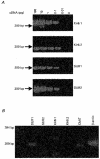

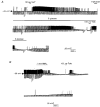
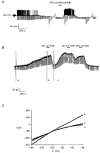
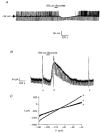

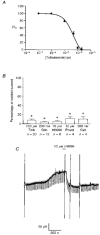

Similar articles
-
Glucose-receptive neurones in the rat ventromedial hypothalamus express KATP channels composed of Kir6.1 and SUR1 subunits.J Physiol. 1999 Mar 1;515 ( Pt 2)(Pt 2):439-52. doi: 10.1111/j.1469-7793.1999.439ac.x. J Physiol. 1999. PMID: 10050011 Free PMC article.
-
Antidiabetic sulphonylureas stimulate acetylcholine release from striatal cholinergic interneurones through inhibition of K(ATP) channel activity.J Neurochem. 1997 Oct;69(4):1774-6. doi: 10.1046/j.1471-4159.1997.69041774.x. J Neurochem. 1997. PMID: 9326309
-
Cell-type specific expression of ATP-sensitive potassium channels in the rat hippocampus.J Physiol. 1999 Jan 15;514 ( Pt 2)(Pt 2):327-41. doi: 10.1111/j.1469-7793.1999.315ae.x. J Physiol. 1999. PMID: 9852317 Free PMC article.
-
Involvement of the n-terminus of Kir6.2 in coupling to the sulphonylurea receptor.J Physiol. 1999 Jul 15;518 ( Pt 2)(Pt 2):325-36. doi: 10.1111/j.1469-7793.1999.0325p.x. J Physiol. 1999. PMID: 10381582 Free PMC article.
-
Striatal interneurones: chemical, physiological and morphological characterization.Trends Neurosci. 1995 Dec;18(12):527-35. doi: 10.1016/0166-2236(95)98374-8. Trends Neurosci. 1995. PMID: 8638293 Review.
Cited by
-
Characterization of an ATP-sensitive K(+) channel in rat carotid body glomus cells.Respir Physiol Neurobiol. 2011 Aug 15;177(3):247-55. doi: 10.1016/j.resp.2011.04.015. Epub 2011 Apr 22. Respir Physiol Neurobiol. 2011. PMID: 21536154 Free PMC article.
-
Intrinsic membrane properties underlying spontaneous tonic firing in neostriatal cholinergic interneurons.J Neurosci. 2000 Nov 15;20(22):8493-503. doi: 10.1523/JNEUROSCI.20-22-08493.2000. J Neurosci. 2000. PMID: 11069957 Free PMC article.
-
Modulation of Excitability of Stellate Neurons in the Ventral Cochlear Nucleus of Mice by ATP-Sensitive Potassium Channels.J Membr Biol. 2018 Feb;251(1):163-178. doi: 10.1007/s00232-017-0011-x. Epub 2018 Jan 29. J Membr Biol. 2018. PMID: 29379989
-
Glucose-receptive neurones in the rat ventromedial hypothalamus express KATP channels composed of Kir6.1 and SUR1 subunits.J Physiol. 1999 Mar 1;515 ( Pt 2)(Pt 2):439-52. doi: 10.1111/j.1469-7793.1999.439ac.x. J Physiol. 1999. PMID: 10050011 Free PMC article.
-
Spontaneous activity of neostriatal cholinergic interneurons in vitro.J Neurosci. 1999 Jul 1;19(13):5586-96. doi: 10.1523/JNEUROSCI.19-13-05586.1999. J Neurosci. 1999. PMID: 10377365 Free PMC article.
References
-
- Ashcroft SJH, Ashcroft FM. Properties and functions of ATP-sensitive K+ channels. Cellular Signalling. 1990;2:197–214. 10.1016/0898-6568(90)90048-F. - DOI - PubMed
-
- Chesselet M-F, Gonzales C, Lin C-S, Polsky K, Jin B-K. Ischemic damage in the striatum of adult gerbils: Relative sparing of somatostatinergic and cholinergic interneurons contrasts with loss of efferent neurons. Experimental Neurology. 1990;110:209–218. - PubMed
-
- Di Chiara G, Morelli M, Consolo S. Modulatory functions of neurotransmitters in the striatum: ACh/dopamine/ NMDA interactions. Trends in Neurosciences. 1994;17:228–233. 10.1016/0166-2236(94)90005-1. - DOI - PubMed
MeSH terms
Substances
LinkOut - more resources
Full Text Sources

